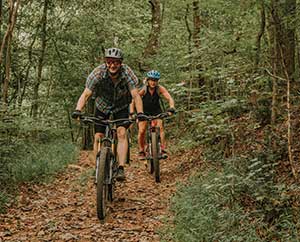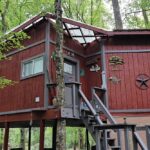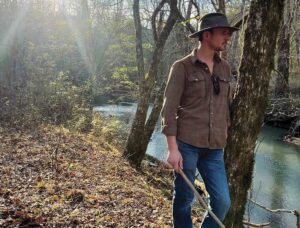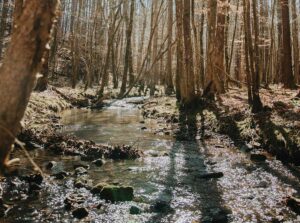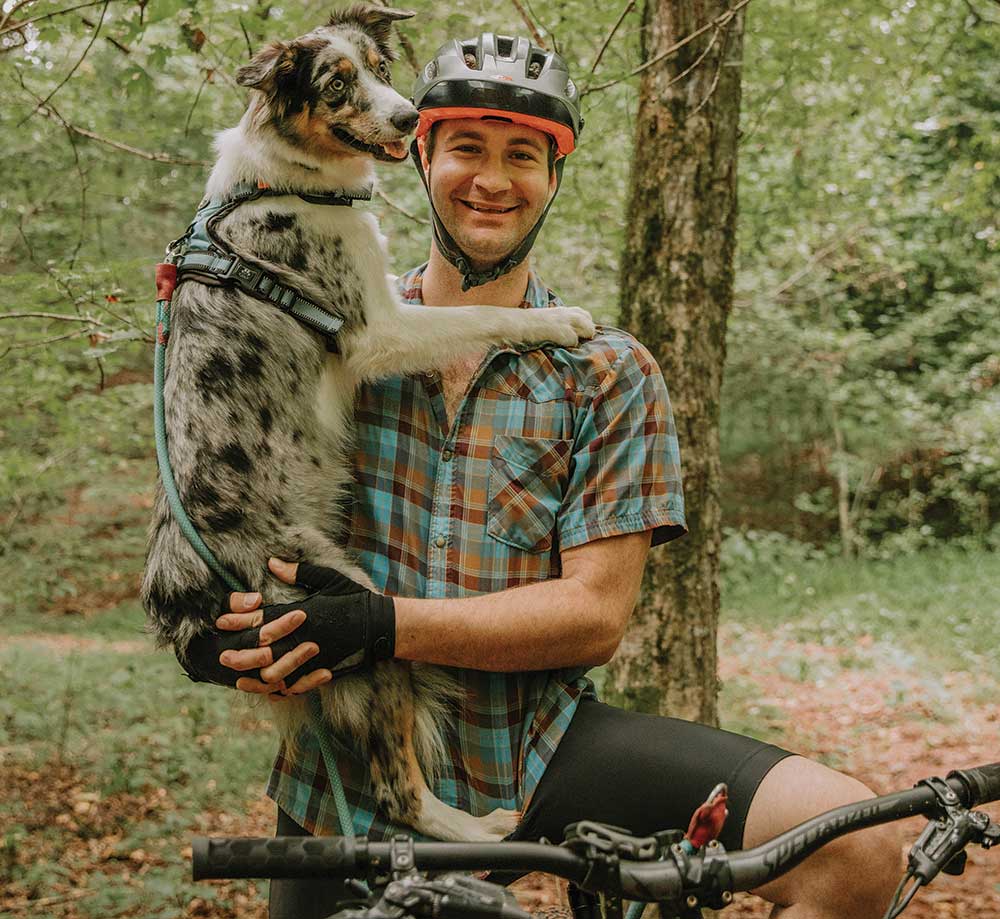
Big Canoe Creek park is set to open soon
Story Scottie Vickery
Photos by Mackenzie Free
Submitted photos
Not long after watching eight turkeys disappear into the forest, Doug Morrison stood on a wooded trail overlooking a stream that flows into Big Canoe Creek. The only sound was the deep whistle of a great crested flycatcher, and Morrison felt pure serenity.
“This is God’s museum,” he said of the surroundings. “There are so many forms of life out here – plants, animals, fish. When you get out in nature and just stop for a moment and take it all in, it’s incredible.”
Soon, many others will be able to experience Morrison’s joy when the “museum,” otherwise known as Big Canoe Creek Nature Preserve in Springville, opens to the public. The project has been a long time coming, but after 14 years of study, planning, roadblocks and hard work, the opening date is nearing, hopefully late October or early November. Morrison, manager of the preserve, couldn’t be more thrilled.
“This is going to be huge,” he said. The preserve – 422 acres of unspoiled terrain – will provide hikers (experienced or beginners), mountain bikers, horse owners, and birding and flora and fauna enthusiasts the chance to unwind, learn and enjoy the great outdoors.
“Being outside in nature can soothe the soul,” Morrison said, and the timing of the fall opening is perfect. “This place shines when the leaves turn. It’s beautiful in the fall.”
Big Canoe Creek, which is part of the Coosa River and flows on the northern boundary of the property, is a vital part of the preserve and a major contributor to the beauty. The main section of the creek, which has been described as “a jewel in the crown of Alabama’s biodiversity,” is more than 50 miles long and flows into Neely Henry Lake. According to The Friends of Big Canoe Creek website, the creek has four major tributaries flowing into it: Gulf Creek, Muckleroy Creek, and two “Little Canoe” Creeks.
The creek is home to more than 50 species of fish, including the rare Trispot Darter, which is listed as “threatened” by the U.S. Fish and Wildlife Service under the Endangered Species Act. Salamanders, snails, crayfish, turtles and mussels – including eight federally listed freshwater species – can also be found in the waters. Just recently, in 2022 the Canoe Creek Clubshell (Pleurobema Athearni), a freshwater mussel found only in the Big Canoe Creek watershed, was listed as “endangered” under the Endangered Species Act.
“Alabama is fourth in the nation in biodiversity, but we’re first in the nation for biodiversity for aquatic species,” Morrison said. “That’s because of all of our rivers and waterways. That’s the kind of thing we want to teach our kids. Our vision is to get kids aways from their electronic devices, get them outside, and teach them about our biodiversity.”
With a motto of “explore and discover,” Morrison said the goal is to soon add outdoor classrooms and bring in experts from agencies like U.S. Fish and Wildlife and the Geological Survey of Alabama to teach students more about the world around them.
Until then, the preserve itself – the creek and 10 miles of hiking, biking and horse trails – is already the ultimate classroom and the perfect background for solace.
“This is really going to be something special,” Morrison said. “This preserve is going to be an asset to every individual who wants to get away from the hustle and bustle.”
Partners in preservation
Morrison knows the importance of that firsthand. After all, a search for a more peaceful life is what prompted him and his wife, Joannie, to move to Springville – just across the creek from the preserve – 24 years ago. “She was looking at the house, and I was looking at the creek,” he said.
A friend introduced him to kayaking, and after a short time of paddling, “I started learning about the critters in our watershed, and I started seeing issues from bad development,” Morrison said. “Sedimentation is a huge issue in our waterways – it’s the number one pollutant.”
Not long after Morrison fell in love with the area that’s now home to the preserve, he learned that he and his community was in danger of losing it. “In 2007, they were planning to develop this, and then in 2008, the economy went south, and the plans were scrapped,” he said. The scare stirred up an interest in preserving and protecting the land.
Fast-forward to 2008, and the effort started gaining traction. The Friends of Big Canoe Creek, a grassroots organization, which Morrison served as president from 2008-2020, learned about Forever Wild Land Trust, which focuses on securing land for public use.
They nominated the land for designation as a Forever Wild site, and after nine years of numerous delays and roadblocks, the first 382 acres were purchased by Forever Wild in 2018, and 40 more acres were added the next year.
St. Clair County and City of Springville leaders – both former and current – embraced the project and have provided tremendous financial support, along with the St. Clair County Economic Development Council.
The Alabama Department of Conservation and Natural Resources, Freshwater Land Trust, The Friends of Big Canoe Creek, Greater Birmingham Community Foundation and The Nature Conservancy have been vital partners, as well, Morrison said. Additionally, Dean Goforth who owns nearby Homestead Hollow, was a key player in making the acquisition a reality. “I don’t think this would have happened without Dean,” Morrison said.
Springville Mayor Dave Thomas pushed for the formation of the Big Canoe Creek Preserve Partners, a nonprofit organization that helps provide sustainable funding of the preserve. As a result, individual and corporate partners have come on board, including Community Foundation of Greater Birmingham, EBSCO Industries, Norris Paving & Excavating, Schoel Engineering, Amerex, Lovejoy Realty, KEBCO, BlueCross BlueShield of Alabama, All American Ford, United Way of Central Alabama and Lawley Resource Management.
There is one key donor for the Preserve Partners who wishes to remain anonymous. “This fella just continually steps up with generous donations at critical times when needed. I wish I could tell you his name, but again, just another one of those good folks in our community that steps up. This community is all in!,” Morrison said.
“It’s been amazing to be a part of this,” Morrison said. “I’m just so proud of and grateful for this community and how hard people have worked to preserve, protect and support this place. Sometimes I have to pinch myself.”
Discover and explore
Although there were a few old logging trails, the land offered a blank slate. Plans were made, and Granger Waid of Norris Paving & Excavating and Joey Breighner of Schoel Engineering, helped ensure the best design came to fruition. In addition to their companies donating tens of thousands of dollars in in-kind work, they provided invaluable input for the project.
“Granger’s vision has everything to do with what this is going to be,” Morrison said. “He brought changes to the original concept that made a tremendous difference, and Schoel Engineering took his concept and did the drawings. Those guys working together was just a godsend.”
For Waid, helping with the project was a no-brainer. “This is something I believe in and I’m passionate about it,” he said. “I’ve been playing in this creek since I was 2 feet tall. People need a place to be able to go and get outdoors.”
Breighner agreed. A 20-year resident himself, “I’m excited about the preserve and what it means to our community.” In addition to the recreational aspect, he pointed to the educational value it holds and looks forward to people being able to “see what the preserve has to offer.”
Through his work on the Springville Planning Commission, he developed a friendship with Morrison, who discussed plans for the preserve as they were building it. “I could see Doug’s passion for the project and when I toured it, I saw some needs.” As executive vice president of Schoel Engineering, he put his and his company’s knowledge and expertise to work for the preserve, donating land surveying and engineering work.
Pointing to all the partnerships and community support involved, Springville Mayor Dave Thomas said, “One of the things Springville and St. Clair County as a whole have earned as a reputation is the level of cooperation rarely seen elsewhere. Everybody appreciates the potential of the preserve that will outlive and outlast us all. It’s generational.”
He talked of the educational component with outdoor classrooms and the ability to bring in experts in the field to teach teachers from around the state who will go back to their schools and teach. Field trips will bring their lessons to life, giving them so much more than a textbook can.
“We have set the bar high to be an example for others that here is what we can do if we work together,” Thomas said. “This is a prime example of people bringing energy that translates into synergy.”
Focusing on details
The attention to preservation will be evident as soon as visitors drive into the parking lot. The top lot has room for cars, trucks and horse trailers, while the bottom lot has plenty of additional spots for cars. The two lots will be separated by a bioretention area with special landscaping designed to filter rainwater and runoff through gravel, sand and topsoil. “We’ll use plants that filter the pollutants from cars and clean the water,” Morrison said, adding that the area will eventually feature a seating area at one end.
Since a major goal of the preserve will be education, there will be a sign with a QR code to connect visitors to videos and photos that explain the concept of bioretention and document the building process. “This is something we hope to promote for any kind of development so that we can trap sediment and clean the water that’s going into our waterways,” Morrison said.
Leaving riparian buffers intact is a vital part of the preserve, as well. “The forest is a riparian buffer for the stream,” Morrison said. “It’s basically leaving the natural vegetation near a stream bank alone” so the trees, plants and shrubs act as buffers to pollutants and help control erosion. That’s why the trails offer a view of the creeks and streams in most areas rather than meandering alongside them.
“You can see the water and you can get down to it if you want, but we left all the vegetation near the streams alone,” Morrison said. “People come out here and say, ‘Look how clear this water is.’ Just look around. You have nothing but trees. The natural vegetation filters everything.
There are a variety of species doing the work. The woods are filled with mountain laurel, native azaleas and oak leaf hydrangeas. There are Bottlebrush buckeye shrubs, red and sugar maple trees, pines and beech trees.
“I call this area Beech Tree Hollow because there are beech trees all over the place,” Morrison said during a recent walk through the woods. “Beech trees keep their leaves longer than other trees, and you don’t really know how many are in here until wintertime.”
Ferns are everywhere, as well. “We’ve got so many different ferns out here, it’s unbelievable,” he said. “I brought a horticulturist from the Birmingham Botanical Gardens out here, and I couldn’t keep him on the trail. He kept wandering off and saying, ‘Look at this, look at this.’”
Morrison gets most excited about the preserve’s aquatic diversity. The Trispot Darter, for example, had not been spotted in Alabama in nearly 50 years before it was discovered in one of Big Canoe’s tributaries in 2008. The removal of Goodwin’s Mill Dam in 2013 brought even more species. The dam was built in the 1880s for a grist mill but hadn’t been in use since the mill closed in the 1940s
Restoring the creek’s flow has provided a larger and more suitable habitat for fish, mussels and other mollusks. Since the dam was removed, the U.S. Fish and Wildlife Service returned just a couple of months ago and was delighted to find the Canoe Creek Clubshell near the site. In 2013, prior to the dam removal, these were not present. “The fish passage returned after the dam removal. Fish serve as host for the mussels, so the fish passage returning was definitely a good thing for these mussels”, Morrison said.
“In a stream in the middle of the Nature Preserve, the Geological Survey of Alabama found a Western Blacknose Dace, a small fish that hasn’t been documented in the Big Canoe Creek Watershed since the ‘80s, so that was a great find, and we will continue to explore,” Morrison said.
News like that is what keeps Morrison motivated and excited about the preserve’s future and impact. He recently stopped at one of his favorite spots on the southern side of the woods to reflect on the opportunity he’ll soon have to share this piece of paradise with the rest of the world. Chances are, he knows the terrain better than anyone else, and he feels a special connection to the land.
“I call this section Slab Creek,” Morris said, pointing to the giant slabs of rock that line the stream’s bed. “They just keep going and going. It’s like a stack of dominoes that got toppled over.” Later, he pointed out two neighboring trees that meet as if in an embrace. “These are the kissing trees,” he said, shortly before telling of another huge tree that was lost in a storm. “I felt like I knew it personally.”
Morrison’s greatest hope is that visitors will love the preserve as much as he does, treat it with the respect it deserves, and treasure it for generations to come.
“It was a struggle getting this thing going,” he acknowledged. “There have been so many trials and tribulations, ups and downs, ebbs and flows. Right now, there’s just good things happening, and I sometimes feel like it’s just destiny. I am very grateful for our Mayor, Dave Thomas, and his leadership through this, the City Council, St. Clair County Commission and Forever Wild. They are seeing what this can become, the educational opportunities, the outdoor recreation and the economic value of greenspace.
For more information about Big Canoe Creek Nature Preserve, or to make a donation to Big Canoe Creek Preserve Partners, visit bigcanoecreekpreserve.org.















